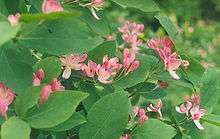Lonicera tatarica
| Lonicera tatarica | |
|---|---|
 | |
| Scientific classification | |
| Kingdom: | Plantae |
| (unranked): | Angiosperms |
| (unranked): | Eudicots |
| (unranked): | Asterids |
| Order: | Dipsacales |
| Family: | Caprifoliaceae |
| Genus: | Lonicera |
| Species: | L. tatarica |
| Binomial name | |
| Lonicera tatarica L. | |
| Synonyms[1] | |
| |
Lonicera tatarica is a species of honeysuckle known by the common name Tartarian honeysuckle.[2] It is native to Siberia and other parts of eastern Asia, but it is probably better known in North America, where it is a widespread introduced species and noxious weed. This plant, one of several exotic bush honeysuckles present in North America,[3] was introduced as an ornamental plant in 1752.[4] It is known across the continent west to Alaska and California, where it easily grows in disturbed habitat. It is a bushy shrub which may approach three meters in erect height. It is lined with oval or rounded leaves 3 to 6 centimeters long. The inflorescence is generally a pair of white to pink to crimson red flowers each about 1.5 centimeters long. The flowers are somewhat tubular, their stamens and styles protruding. The fruit is a shiny orange or red berry up to a centimeter wide. The plant forms thickets and spreads easily when birds and other animals consume the fruits.
References
- ↑ "The Plant List: A Working List of All Plant Species". Retrieved 7 December 2014.
- ↑ "BSBI List 2007". Botanical Society of Britain and Ireland. Archived from the original (xls) on 2015-02-25. Retrieved 2014-10-17.
- ↑ US Forest Service Weed of the Week
- ↑ Invasive.org